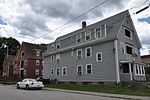House at 3 Dean Street
Houses completed in 1878Houses in Southbridge, MassachusettsHouses on the National Register of Historic Places in Worcester County, MassachusettsNational Register of Historic Places in Southbridge, MassachusettsQueen Anne architecture in Massachusetts ... and 1 more
Worcester County, Massachusetts Registered Historic Place stubs

The House at 3 Dean Street in Southbridge, Massachusetts is a rare well-preserved example of a worker housing cottage built by the locally important American Optical Company. It is a small 1+1⁄2-story house, three bays wide, presenting its side to the street. At the time of its listing on the National Register of Historic Places in 1989, it still had the original siding from its original construction, about 100 years earlier, which included cut shingles in the gable, and bracketed eaves. These details have since been lost or obscured by the application of modern siding (see photo).
Excerpt from the Wikipedia article House at 3 Dean Street (License: CC BY-SA 3.0, Authors, Images).House at 3 Dean Street
Dean Street,
Geographical coordinates (GPS) Address Nearby Places Show on map
Geographical coordinates (GPS)
| Latitude | Longitude |
|---|---|
| N 42.075555555556 ° | E -72.028333333333 ° |
Address
Dean Street 15
01550
Massachusetts, United States
Open on Google Maps











